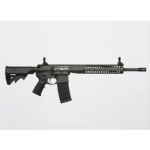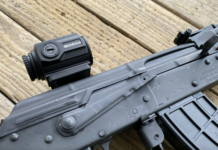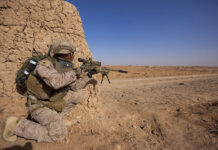
Keith is getting too good at writing articles for us here at 248shooter. We both started a review on the ALG Combat Trigger also known as that ACT trigger. He just did a better job than me and faster. Below is the article from him and I do not want to spoil it so let me just say the following.
My conclusions have been directly inline with his. While we took a different path to get to the ALG/ACT trigger we reached the same outcome. If you are debating a trigger upgrade read this article first. Even as a novice it is simple to assemble and easy to work with. I think it took me 15 minutes and it was my first AR trigger replacement.
OOOH SHINY!
That was basically my reaction on seeing the trigger for the first time.
ALG Defense, the people behind the ACT, released an aesthetically appealing trigger into the US market at a time when the market is all about highly functional aesthetics.
The question for us is, does the shiny object function? I was looking to find out.
The Search
I recently completed two AR15 builds from home (article coming, stay tuned), one for myself and one for the little lady. During that search process there is an endless sea of parts you can grab up to complete your rifles. Some of these add fashion, some add function, many advertise adding both, and some end up adding neither.
I wanted quality, functional, and durable rifles for a reasonable price (don’t we all). That process is all about spending on critical areas, but not over buying for your purpose. That can be very hard ladies and gentlemen… very, very hard.
The online retailers are full of ball park $200.00 triggers from the legendary names in the industry, Timney and Geissele. New products like the Tac-Con 3MR are $500.00 and new offerings from companies like HiperFire put new design concepts into play at that $200.00 price point yet again.
The new triggers especially seem to claim they have discovered revolutionary new ways to make guns go bang, as if the old ways didn’t work? Of course, internet conventional wisdom also concludes in certain circles that “Mil-Spec” triggers are the worst thing ever to be thrust upon American gun buyers.
“Gritty, horrible, sloppy, inaccurate!” the internet arm-chair commandos cry!
The online retailers don’t help this any when they list their basic triggers. It’s not that they trash the trigger and say buy the expensive ones. It’s the more passive not saying much of anything while the long detailed description on the other trigger sells itself.
So we have the “upgraded” trigger with the catchy super tactical match sniper description vs. the mil-spec trigger which wraps up its description as “trigger”. Retailers want us to buy the higher priced items (ya don’t say?) but my goal was to get a good trigger for the task at hand. More importantly, get a good trigger for my young lady, a novice AR shooter who didn’t want anything fancy on her rifle.
That leads me toward the under advertised “Mil-Spec” side to have maximum value and get the job done.
On mil-spec triggers themselves being “barely adequate”, I can only share my experience. In the summer of 2007 I was handed a well abused rifle, bluing was gone, colors were fading on the receiver from black to purple, pitting all barrel and front sight, and it loved to collect surface rust. I had no knowledge of what this thing did, how it worked, or whether it was good or bad. I spent a month smacking the living hell out of it and learning to clean it before ever firing a shot. When it came time to fire those shots I had no bias, I had never heard of “match triggers” and had no excuses to give except my own shooting abilities if I did poorly.
That summer I consistently and accurately hit targets at 200, 300, and 500 yards away both slowly and quickly with open iron sights while standing, sitting, kneeling, and prone. That trigger probably exhibited all the flaws that haters of mil-spec despise. I still hit the target. Mil-spec works.
I have, since those summer days, learned a great deal, one such detail is quality control in manufacturing, and a friend of mine ran afoul of that with his “mil-spec” trigger. Most triggers, especially well-worn ones, have smoothed out the metal on metal surfaces providing either one or two distinct stages before the trigger breaks and the gun fires. His trigger had six. Poor machining and low quality control had yielded a trigger that was mil-spec material but improperly made. These triggers are what give “Mil-Spec” a bad name.
So, back to my goal of finding performance without overspending, I needed a quality mil-spec trigger to put in the rifles but not buy something cheap stamped “mil-spec” and have the QC problems.
So off I went to the magic of the internet and searched that very thing. Up popped ALD Defense with a product called the QMS Trigger, and right their next to it was the ACT… it was shiny and only $20.00 more.
I took once more to the internet and tried to figure out if shiny was good.
The Trigger
The ACT is, at its heart, a mil-spec trigger, same shape, same pieces, and same springs. ALG Defense didn’t try to re-invent a wheel that already works, just smooth out the ride.
To accomplish this they didn’t look at redesign, the looked at materials.
Nickel-Teflon and Nickel-Boron over quality steel make this trigger excel without breaking the bank. The coatings also add the subtle two-tone coloration, bonus. Nickel-Teflon, an extremely durable coating that also adds lubricity to metal, coats the hammer and disconnector (the thin steal piece slid into the center of trigger hook piece, it grabs the hammer as it comes back) The majority of your high velocity metal on metal contact on the trigger is on these two pieces, the coating of Nickel-Teflon makes the firing sequence wear less on these parts due to its hardness and provides a very clean and polished feel to the trigger pull due to the lubricity of Teflon. The result is a very clean feeling to the trigger pull, satisfyingly clean, while not sacrificing any reliability.
Other triggers have used lighter weight springs and machined down hammers to achieve lighter, easier, or “cleaner” trigger pulls but risk failing to ignite the round by hitting the firing pin and primer too lightly.
The trigger pulls at around 6 lbs of force, above the 5.5lb minimum of mil-spec but well below the maximum of 9.5lbs, a perfect weight for an all-purpose rifle.
The shinier bottom half of the trigger, the trigger hook itself where we place our finger while taking the shot, is Nickel-Boron coated. The coating still provides increased lubricity and durability but is much more centered on the durability overall, being that it is an openly exposed part. Nickel-Boron is increasingly popular in the manufacturing of firearms metal on metal components, adding exceptional corrosion resistance and durability to the treated parts.
It doesn’t look half bad either. If the look bothers you… maybe for “tactical” reasons of not having anything overly shiny on your gun, you can paint and/or coat the Nickel-Boron. DO NOT mess with the Nickel-Teflon parts as they will cease being useful if covered in paint or any other firearm finish.
Some Assembly Required
Some of the higher end triggers do have an additional advantage. They are “drop-in” units. The trigger mechanism is all contained in a nice little box waiting to be put into the receiver and pinned in place.
Not so with the ACT (and many others). The first trigger I ordered came with a full lower parts kit, since I needed one and the trigger on its own is $65.00 give or take while the parts kit one was $80.00, seemed like a no brainer. I was correct there but that is for the full build article.
The ACT comes to us partially assembled (See photo). What you see there is what you get. The trigger disconnector and the little spring it rides on are in the trigger hook assembly already in place, the spring for the trigger is already on and the pin (another materially upgraded part) is in its place. The hammer is similarly outfitted with its proper spring and pin.
And then there is this little guy…

The only piece standing alone. What could it be for?
Turns out the fine folks at ALG have assembled a lower or two themselves and have provided this helpful little piece to aid us. It’s an extra length of pin the same diameter as the two inside the trigger pieces, it’s also long enough to hold the trigger and disconnector together but short enough to fit inside the lower receiver. It’s a place holder so you can feed in the pins without holding a bunch of pieces under different directions of spring tension and it guides the pin and holds the parts in place as they go through the receiver, so parts fly everywhere a lot less frequently. The same thing can be done for the hammer, very helpful in keeping parts in place under spring tension.
Thank you ALG! It’s the little things.
Pulling the Trigger

So now the trigger is sitting in the gun in front of us. We do a function check to make sure everything stops where it is supposed to, locks, releases, resets, etc.
Side Note: PLEASE DO NOT REPEATEDLY DRY FIRE AN AR TRIGGER WITHOUT A PROPERLY INSTALLED UPPER AND BCG, The steal hammer crashing against the aluminum receiver instead of the BCG and firing pin can and WILL eventually crack your receiver, which sucks, once or twice probably won’t hurt anything but repeatedly doing it will cause problems.
Once I knew the triggers were all together in both guns I went one afternoon with a couple of buddies to a nearby indoor range to throw lead.
Conclusion: This is my new baseline trigger, everything will be judged by this standard. It’s phenomenally consistent, no grit or creep, clean break, sharp reset, and it will do it again and again and again.
If you won’t take my word for it, look at BCM and LWRCi, the Jack Carbine and Individual Carbine are both running these triggers from the factory. Both of those guns are built as “get it done” fighting rifles, so they chose a trigger to match that need instead of a match trigger they didn’t need.
So in short, ALG Defense has quite the winner on their hands. A cost effective, well thought out, and rugged trigger meant for rifles that could be called on for a serious purpose, however they’re just as at home in a hobby rifle and very kind on the pocket book.
It’s just a damn good trigger.





